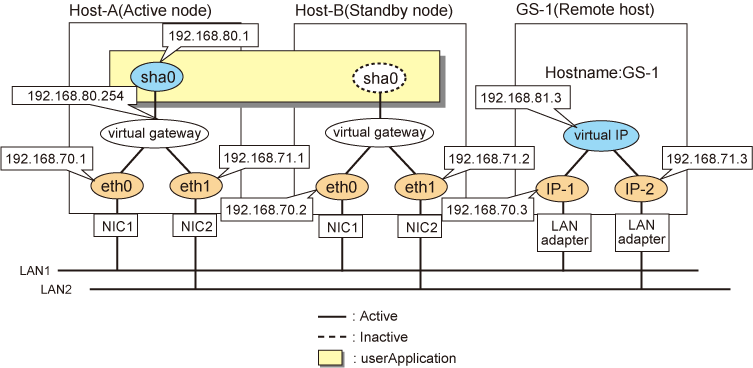This section describes an example configuration procedure of the network shown in the diagram below.
For the network configuration other than GLS, refer to "3.2.2 Network configuration".
For the GS configuration, refer to GS manual.
For configuring the cluster system, refer to the Cluster system manual.
In this section, description of private LAN is omitted.
The dotted line indicates that the interface is inactive.

[HOST-A]
1) Setting up the system
1-1) Define IP addresses and hostnames in /etc/hosts file.
192.168.70.1 host11 # HOST-A Physical IP 192.168.71.1 host12 # HOST-A Physical IP 192.168.70.2 host11 # HOST-B Physical IP 192.168.71.2 host12 # HOST-B Physical IP 192.168.80.1 hosta # HOST-A/B Virtual IP(Takeover virtual IP) 192.168.80.254 virgw # Virtual gateway 192.168.70.3 gs11 # GS-1 Physical IP(IP-1) 192.168.71.3 gs12 # GS-1 Physical IP(IP-2) 192.168.81.3 gsa # GS-1 Virtual IP |
1-2) Configure /etc/sysconfig/network-scripts/ifcfg-ethX (X is 0,1) file as follows.
Note
The following setting example (/etc/sysconfig/network-scripts/ifcfg-ethX) is for RHEL5. For details, see "3.2.2 Network configuration".
Contents of /etc/sysconfig/network-scripts/ifcfg-eth0
DEVICE=eth0 BOOTPROTO=static HWADDR=XX:XX:XX:XX:XX:XX HOTPLUG=no BROADCAST=192.168.70.255 IPADDR=192.168.70.1 NETMASK=255.255.255.0 NETWORK=192.168.70.0 ONBOOT=yes TYPE=Ethernet |
Contents of /etc/sysconfig/network-scripts/ifcfg-eth1
DEVICE=eth1 BOOTPROTO=static HWADDR=XX:XX:XX:XX:XX:XX HOTPLUG=no BROADCAST=192.168.71.255 IPADDR=192.168.71.1 NETMASK=255.255.255.0 NETWORK=192.168.71.0 ONBOOT=yes TYPE=Ethernet |
1-3) When the system is RHEL, on the /etc/sysconfig/network file, define a statement which enables the network configuration.
NETWORKING=yes |
1-4) Set the static route information of the virtual gateway for the remote host's virtual IP address in /etc/sysconfig/network-scripts/route-"interface name".
Contents of /etc/sysconfig/network-scripts/route-sha0
GATEWAY0=192.168.80.254 # Virtual gateway NETMASK0=255.255.255.255 # Subnet mask ADDRESS0=192.168.81.3 # GS-1 Virtual IP |
2) Reboot
Run the following command to reboot the system. After rebooting the system, verify eth0 and eth1 are active using ifconfig command.
/sbin/shutdown -r now
3) Setting a subnet mask
/opt/FJSVhanet/usr/sbin/hanetmask create -i 192.168.80.0 -m 255.255.255.0
4) Creating of virtual interface
/opt/FJSVhanet/usr/sbin/hanetconfig create -n sha0 -m c -i 192.168.80.1 -t eth0,eth1
5) Setting the Communication target monitoring function
Setting the Remote host monitoring information:
/opt/FJSVhanet/usr/sbin/hanetobserv create -n GS-1 -i 192.168.81.3 -t 192.168.70.3,192.168.71.3
Setting the Standby node monitoring information:
/opt/FJSVhanet/usr/sbin/hanetobserv create -n HOST-B -i 192.168.80.1 -t 192.168.70.2,192.168.71.2
Note
When you set the operation node monitoring information, be sure to specify the takeover IP address with the "-i" option.
6) Setting a virtual gateway
/opt/FJSVhanet/usr/sbin/hanetgw create -n sha0 -g 192.168.80.254
7) Creating of takeover virtual interface
/opt/FJSVhanet/usr/sbin/hanethvrsc create -n sha0
[HOST-B]
1) Setting up the system
1-1) Define IP addresses and hostnames in /etc/hosts file. Defined information is the same as for HOST-A.
1-2) Configure /etc/sysconfig/network-scripts/ifcfg-ethX (X is 0,1) file as follows.
Note
The following setting example (/etc/sysconfig/network-scripts/ifcfg-ethX) is for RHEL5. For details, see "3.2.2 Network configuration".
Contents of /etc/sysconfig/network-scripts/ifcfg-eth0
DEVICE=eth0 BOOTPROTO=static HWADDR=XX:XX:XX:XX:XX:XX HOTPLUG=no BROADCAST=192.168.70.255 IPADDR=192.168.70.2 NETMASK=255.255.255.0 NETWORK=192.168.70.0 ONBOOT=yes TYPE=Ethernet |
Contents of /etc/sysconfig/network-scripts/ifcfg-eth1
DEVICE=eth1 BOOTPROTO=static HWADDR=XX:XX:XX:XX:XX:XX HOTPLUG=no BROADCAST=192.168.71.255 IPADDR=192.168.71.2 NETMASK=255.255.255.0 NETWORK=192.168.71.0 ONBOOT=yes TYPE=Ethernet |
1-3) When the system is RHEL, on the /etc/sysconfig/network file, define a statement which enables the network configuration.
NETWORKING=yes |
1-4) Set the static route information of the virtual gateway for the remote host's virtual IP address in /etc/sysconfig/network-scripts/route-"interface name". The information is set in the same way as for HOST-A.
2) Reboot
Run the following command to reboot the system. After rebooting the system, verify eth0 and eth1 are active using ifconfig command.
/sbin/shutdown -r now
3) Setting a subnet mask
/opt/FJSVhanet/usr/sbin/hanetmask create -i 192.168.80.0 -m 255.255.255.0
4) Creating of virtual interface
/opt/FJSVhanet/usr/sbin/hanetconfig create -n sha0 -m c -i 192.168.80.1 -t eth0,eth1
5) Setting the Communication target monitoring function
Setting the Remote host monitoring information:
/opt/FJSVhanet/usr/sbin/hanetobserv create -n GS-1 -i 192.168.81.3 -t 192.168.70.3,192.168.71.3
Setting the Active node monitoring information:
/opt/FJSVhanet/usr/sbin/hanetobserv create -n HOST-B -i 192.168.80.1 -t 192.168.70.1,192.168.71.1
Note
When you set the operation node monitoring information, be sure to specify the takeover IP address with the "-i" option.
6) Setting a virtual gateway
/opt/FJSVhanet/usr/sbin/hanetgw create -n sha0 -g 192.168.80.254
7) Creating of takeover virtual interface
/opt/FJSVhanet/usr/sbin/hanethvrsc create -n sha0
[Configuration by RMS Wizard]
After completing the procedure 7) for HOST-A and HOST-B, use the RMS Wizard to set up the cluster environment.
Select the SysNode for HOST-A and HOST-B when creating GLS resources, and then register the created GLS resources with the cluster applications.
When registering the GLS resources with the cluster applications, select the SysNode for HOST-A and HOST-B in order of the operation node and the standby node, and then register the takeover IP address "192.168.80.1".
After completing the configuration, start the userApplication to activate the takeover virtual interface on the operation node.
[GS-1]
Set the information for HOST-A's physical IP address and virtual IP address. For information on how to do this, see the GS manual.